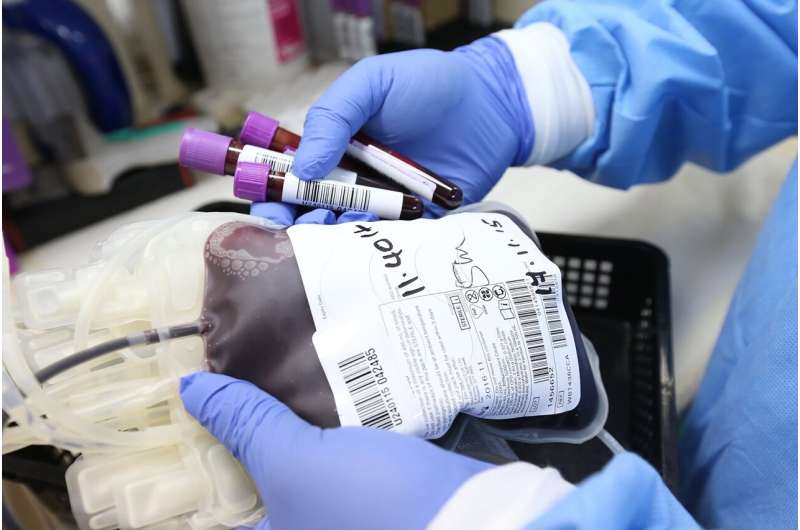
The current strategy used in Europe to mitigate malaria transfusion risk is efficient with just 10 reported cases over the 20 past years. However, current serological tests used to identify “at risk” donors are not sensitive enough to completely eliminate the risk.
In a presentation to be given at this year’s ESCMID Global Congress (formerly ECCMID) in Barcelona, Spain (27–30 April), Dr. Sophie Le Cam from the French transfusion blood service (Etablissement Français du Sang [EFS]), discusses the ongoing efforts being made to prevent transfusion-associated malaria in Europe and outline the different malaria screening strategies that need to be combined in order to ensure the safety of blood transfusions going forward.
Transfusion-transmitted malaria (TTM) is an accidental Plasmodium infection caused by whole blood or a blood component transfusion from a malaria infected donor to a recipient. Just a few parasites in a unit of blood are enough to cause infection, and all Plasmodium species are able to survive in stored blood, even if frozen, and retain their viability for at least a week. Ten cases of TTM have been reported in Europe over the last 20 years, in France, Spain, the UK, Italy, and the Netherlands.
Dr. Le Cam highlights an important difference between natural malaria infection and TTM, saying, “When individuals are infected naturally with malaria from a mosquito bite they undergo an initial asymptomatic phase which allows immunity cells to be activated against malaria parasites.
“But infected blood transfusions directly release malaria parasites into the bloodstream triggering high risk complications that can potentially lead to a fatal outcome, especially in non-endemic countries where the majority of individuals have never been exposed to malaria, and in immuno-compromised patients such as those with cancer and the elderly.”
Europe has a mandatory directive to prevent TTM, which recommend that people who have recently traveled to a country with malaria, or former residents of areas where malaria is present, cannot donate blood for at least six months and three years after they return, respectively.
In many countries, this deferral period can be reduced to four months if a negative malaria test is shown before each donation. However, existing microscopy and serological tests used to mandate these rules are not sensitive enough to reliably mitigate malaria transfusion risk.
Microscopic examination is the “gold standard” for diagnosis of malaria illness, but is not adapted to blood bank activities in Europe. Serologic tests are widely used, but their sensitivity and specificity are not as good as expected.
According to Dr. Le Cam, “The risk that is most difficult to mitigate comes from donors born, or who lived their early childhood, in malaria-endemic countries who can develop an immune-tolerance—a host response that protects against high numbers of parasite and illness without eliminating the infection.”
In these infectious immune-tolerant individuals, cases of TTM have been linked to blood donations given more than five years after the last potential exposure of the donor to P. falciparum, and several decades in the case of P. malariae.
As Dr. Le Cam explains, “These asymptomatic infections characterized by low parasite densities require more sensitive methods for detection such as recent molecular methods. But while a fully automated molecular method may be the ideal screening method for malaria infection in the blood donor population, it is an expensive option.”
Le Cam sees the current challenge to optimizing the testing strategy in non-endemic countries as enhancing screening sensitivity for immuno-tolerant donors without compromising the availability of blood products.
“On one hand, the limited number of potentially infected donors requires a cost-effective strategy of blood donor screening, but on the other, the accuracy of screening needs to be optimal for the serious outcomes of TTM in malaria naïve and immuno-compromised recipients,” she says.
What needs to be done to make TMM a thing of the past in Europe?
According to Dr. Le Cam, “The key to transfusion security remains the deferral period after the return of donors from endemic countries. But we really need to develop new testing strategies. The parasite inactivation of blood using new technologies that are able to selectively inactivate pathogens without damaging cells or plasma could also be a good option, but the technology is not completely reliable for packed red blood cells and is very expensive.
“Ultimately, different strategies need to be combined in order to ensure the safety of blood transfusions in Europe that include blood donor screening by appropriate diagnostic tools, which should probably include molecular tests.”
Provided by
European Society of Clinical Microbiology and Infectious Diseases
Citation:
Making transfusion-transmitted malaria in Europe a thing of the past (2024, April 26)
transfusion-transmitted-malaria-europe.html
.
. The content is provided for information purposes only.
